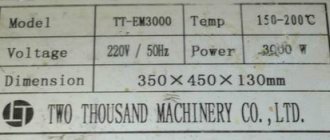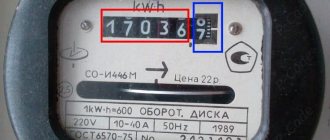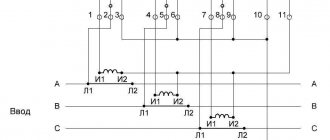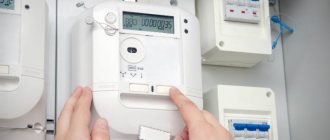Old inductive meter with aluminum disk
I present to the readers the next article of the Article Contest. The author of the article is Evgeniy Rusinov.
Evgeniy’s article is a study on how the readings of old induction meters differ from new electronic ones. A comparison has been made, and not in favor of electronic ones. But let’s not get ahead of ourselves, let the author speak.
After many friends, including myself, installed electronic two-tariff and single-tariff electric meters instead of induction ones at the request of electricity supply organizations, by the end of the month the situation was changing not in favor of the consumer. Receipts for paying for electricity indicated inflated kilowatt-hours, compared to the readings of the old meter for similar use of household electrical appliances. The question arises: why does replacing an induction meter with an electronic one lead to such results?
In this article, we will consider cases in which there is a discrepancy in the readings of the SOE-505 induction meter and the SOE-55 50Sh-T-112 electronic series, with accuracy classes 2 for the first and 1 for the second. Both meters are from the same manufacturer - MZEP, Moscow Electrical Appliances Plant. Photo of the old induction meter - at the beginning of the article, the new electronic meter looks like this:
New electronic meter with LCD screen
According to the passport data, one revolution of the aluminum disk corresponds to 1.67 W of consumed electricity, while one pulse of the LED lamp of the electronic meter signals one watt consumed per unit of time.
I recommend reading the articles on SamElectric on the design and installation of electronic meters.
Experimental data on checking the error of induction and electronic electricity meters
To begin with, I connected an active load to both types of meters in the form of an infrared heater of the IK-2.0 brand with a power of 2 kW.
After one minute, the readings on the metering devices were: the electronic one counted 34 pulses, the induction disk made 20 revolutions. Taking into account the length of the connected cable and the transition resistance at the points of its connection, both meters counted 34 W each. According to the heater's datasheet, the power consumed from the network is 2 kW per hour. From the course of electrical engineering it is known that the power of the active load in alternating current circuits is equal to the product of current and voltage. Since IR-2.0 theoretically consumes 2 kW in 60 minutes, then dividing 2000 W by 60 minutes we get that in one minute its electricity consumption will be 33.33 W.
The technical characteristics of both meters indicate that they only take into account active load . But in the passport data of the electric meter SOE-55 50Sh-T-112 there is a point indicating that it keeps track of the total power consumed by the voltage and current circuits, 8 VA and 0.04 VA respectively, that is, it also takes into account the internal reactive power !
Then, for testing, I used an active-inductive load as a LB-2*40 lamp, considering it only as active. The result was the following: an induction counter in 1.15 minutes. “counted” 1.67 W, and the electronic one 2 W for the same time, where the difference was 0.33 W.
This is due to the fact that in addition to active power, an electronic meter also takes into account reactive power , which creates an additional load on electrical networks, but is not taken into account by inductive meters.
Five reasons for over-metering of electricity consumption by new electronic electricity meters
In the article, the author describes situations when, after installing new electronic electricity meters, they will count, in the same apartments, more electricity consumption than the old induction ones. Explains the reasons for over-metering, provides diagrams and gives recommendations for eliminating shortcomings and saving energy.
Electricity consumer complaint: “I live in water from apartments in an apartment building. Previously, to account for electricity consumption in my apartment, a CO-2 induction electric meter was installed in the power panel on the staircase; it counted for many years, in winter more in summer, less, but there was no more than 100 kW/hour per month. Now “Kievenergo” has replaced it and installed an electronic electricity meter NIK 2102 and it totals 2 times more, and this despite the fact that the load in my apartment has not changed.”
There are a lot of similar complaints on the Internet. Let's look at the reasons for over-metering of electricity by electronic meters.
New electronic-mechanical meters
Old induction electricity meters of the CO-2 type, installed en masse and for a long time in our apartments, counted active power, many hearths worked reliably, but had a number of disadvantages. Among them, low sensitivity, they only took into account powers above 11...22 W (depending on the accuracy class), further, they could easily be deceived, i.e. stop electricity metering, which is what the “craftsmen” did en masse. All egos led to losses for energy supply organizations, which have now become private, and the private owner will not tolerate losses. Therefore, on the instructions of energy supply organizations, designers have developed new, electronic (electromechanical) electricity meters (ES) that are devoid of the above disadvantages. The market is oversaturated with such ES, among them the electronic-mechanical electric meter type NIK 2102 (Fig. 1), which is produced in Ukraine and has many modifications, which is often mentioned on the Internet. It fully complies with the requirements of energy sales, namely, it considers active power and has high sensitivity, because takes into account power consumption above 2.75 W (and not 11...22 W as in CO-2). It contains many methods of protection against electricity theft. Among them, high immunity to artificial external magnetic fields and external radio emissions, and also, depending on the model, one current sensor can be installed (only in the phase wire), or two current sensors (in the phase and neutral wire).
You can find out how many current sensors your NIK 2102 electric meter has by three criteria.
- The first sign, according to the type of model written on its front panel, for example, in the model НІК 2102-02.М2В the number after the letter “M” indicates the number of current sensors, in this case “2”.
- The second sign is the presence on the same panel of an LED with the inscription “EARTH” and “REVERSE” (Fig. 1); electric meters with one current sensor do not have these LEDs. By the way, the “REVERSE” LED lights up when “craftsmen” send current in the opposite direction in order to steal electricity.
Rice. 1
- The third sign is that on the front panel of the ES there is a sign indicating how many current sensors are in this model; the sign is a vertical stick with one or two rings at its ends. One ring - one current sensor, two rings - two current sensors.
Energosbyt really likes the ES NIK 2102 with 2 current sensors and installs them en masse and free of charge in power metal panels in all our apartment buildings.
Where does energy sales come from so much love for new electric meters with 2 current sensors? And the whole trick is that the ES takes into account the energy consumption according to the readings of the sensor (phase or zero) through which the greater current flows. On the one hand, this makes it difficult to steal electricity, but on the other hand, it allows energy sales electricians to incorrectly connect ES and thereby deceive consumers, i.e. charge them a bill for electricity that they do not actually consume.
Areas of responsibility
Before understanding all the reasons for over-metering of electricity, it is necessary to know the areas of responsibility of the power grid sections, i.e. who is responsible for what.
The housing office or the electrician of the joint owners of the apartment building is responsible for the power switchboard of an apartment building (on the staircase).
Energosbyt is responsible for the electrical system in the electrical panel of an apartment building and its connection wires (to the circuit breakers AB), as well as the sealing and operation of the electrical system.
The owner of the apartment is responsible for the electrical wiring of an apartment or apartment building, starting from the circuit breakers (AB) in the power panel.
In a private house, everything belongs to the owner of the house: the power panel, the electric meter, the house's electrical wiring and grounding (if any), but the seals on the electric meter belong to the energy sales company, and they cannot be torn off after sealing.
So, let's consider 5 reasons for the overestimation of ES of the new generation of electricity.
- Energy sales electrician, replaced an old electrical system in the electrical panel of an apartment building with an electronic one with two current sensors
But he connected it according to the wrong circuit, which is why the ES produces much more electricity than the apartment owner consumes. This is one of the most common reasons for overbilling electricity.
Looking through the Internet, I was surprised that no one even knows about this scam by energy sales electricians, but it is used all the time.
In Fig. Figure 2 shows two wiring diagrams for connecting the ES in the power panels of our apartment buildings; in Fig. 2, a there is a diagram of the correct connection of the ES, and in Fig. 2, b there is a diagram of the incorrect one.
Rice. 2
It is correctly turned on - this means that the output of the neutral wire from the electrical system to the apartment should be direct (Fig. 2, a), and not in a gap, through the electrical panel housing (Fig. 2, b). When turned on correctly (Fig. 2, a), the same current flows in both wires of the ES (phase and zero), and the ES correctly charges electricity.
But often, the electrician, either due to his incompetence, or on purpose, connects the electrical system to the apartment incorrectly (Fig. 2, b). Those. The output of the neutral wire from the ES and its entrance to the apartment are connected not directly, but through the metal housing of the power electrical panel, and even under one clamp bolt with neighbors (Fig. 2, b). Then, additional current circulating in the metal body of the electrical panel will be mixed into the neutral wire from the neighbors in the electrical panel, and the ES will charge you with additional electricity that you do not consume.
The circulation diagram of the neutral wire currents in the metal casing of the electrical panel changes all the time, because depends on the ratio of current consumption of all neighbors’ apartments in the electrical panel. Usually there are 3-4 electrical switchboards in electrical panels, but in Fig. 2, for simplicity, only two are shown.
Moreover, neighbors can influence your ES in the same way as you influence it, naturally, if they are also turned on according to the wrong scheme (Fig. 2, b).
To be fair, it should be noted that the designers of an ES with two current sensors, the same NIK 2102, provided an “EARTH” LED on its front panel (Fig. 1). Its glow indicates that different currents are passing through the phase and neutral wires; this is not a normal condition and you are charged additional electricity that you do not consume.
It is very easy to identify the reason for the glow of the EARTH LED; there are two options.
- First. Check the circuit, i.e. wires, ES connections. The neutral wire from the ES must be connected directly to the apartment (Fig. 2, a), and not through the electrical panel housing (Fig. 2, b).
- Second. In the power panel, turn off the power supply to your apartment (turn off the AB automatic switches), the “EARTH” LED on your ES will go out. After which, the load must be replaced with a portable incandescent lamp 230 V 100 W, i.e. turn it on as shown in Fig. 3. If the “EARTH” LED lights up, this indicates that the electric meter is not turned on correctly, and the electrician who did this is to blame.
Rice. 3
In new apartment buildings, with new electrical wiring, the above-described problems with ES, as a rule, do not occur, but in old Soviet-built buildings, they are all too common.
How to act in a situation when you discover that on your electricity meter, in the power panel of an apartment building, the “EARTH” LED is glowing. There are three options.
- First. Write an application addressed to the director of the energy sales (RES) of your area, in which, in addition to your address and your data, you indicate that the “EARTH” LED is lit on the ES of your apartment and that the electrical wiring of your apartment is working properly, and that the electrician of the energy sales will eliminate this deficiency. The application must be written in 2 copies, one must be left in the director’s reception area, and the second, with the “incoming” stamp, must be kept at home.
- Second. At the appointed time, you can come to see the director, but you must write an application, because oral conversation is empty talk, and no one will come to you.
- Third. Call the power supply electricians, pointing out the above-mentioned deficiency. This is the simplest option, but also the most unpromising, because... there is almost no chance that an electrician will come to you; they will simply “football” you, as was the case with the author of this article.
If the electrician of the energy sales, on the instructions of the director, nevertheless comes to you to eliminate the deficiency, then he will definitely lie to you that your neighbor, who connected to your meter, is to blame. You will hate your neighbor, consider him your enemy and even quarrel with him, but he is absolutely innocent and does not even know about it. But in fact, all the blame lies with the energy sales electrician, but he will never admit it [1]. But your task, when it appears, is to eliminate the deficiency.
- Poor insulation of electrical wiring in your apartment or private house (dacha)
As a result, the electric meter contains additional electricity, even in the absence of a payload. This is another reason for the increased metering of electricity by the electric meter, but the energy supply company is not to blame, because The electrical wiring of an apartment (private house) belongs to its owner.
Poor insulation in electrical wiring, both between wires and “to the ground,” may be due to its old age, or moisture (water) getting into the electrical wiring, for example, your neighbors flooded you. The same situation can happen in a cable that you laid in the ground to a garage, or a summer kitchen, or a bathhouse on the territory of a summer house or private house, and groundwater, the worst enemy of insulation, got into this cable.
According to the standards of the “Rules for Accounting for Electrical Installations” (RUE), the insulation resistance of electrical wiring must be at least 0.5 MOhm. But ES begin to take into account electricity from current leakage, at much lower insulation resistance values. For example, old ES type SO-2 take into account powers above 11...22 W, which corresponds to an insulation resistance below 4.4...2.2 kOhm. New, electronic ES have a higher sensitivity; they take into account electricity with a power above 2.75 W, i.e. if the insulation resistance is less than 17.6 kOhm. When the insulation resistance of the electrical wiring is below the above threshold, the ES generate electricity “day and night”, regardless of whether you consume electricity or not.
A specialist knowledgeable in electrical engineering should identify low insulation in electrical wiring. As you know, an electronic-mechanical ES, the same NIK 2102, when counting electricity, blinks an LED. By disconnecting sections of electrical wiring one by one, the specialist identifies electrical wires with reduced insulation, measures the insulation resistance with a device, and makes a conclusion about the need to replace the wiring. Faulty, i.e. The culprits of current leakage may also be automatic circuit breakers AB (Fig. 2, a) installed in power panels, although this happens rarely, but a specialist should check them too. Based on the results of the examination, the specialist makes a conclusion.
If you, without inspecting the apartment electrical wiring, complain to the electricians of the energy sales about the large electricity metering of the new ES, then they, in order not to deal with the essence of the problem, will answer you in the standard way: “Change the electrical wiring, the energy sales is not responsible for the electrical wiring of your apartment.” The owner of the apartment, having received such a “competent conclusion” without an inspection, spends a lot of money, changes the wiring, and the ES, as he counted 2 times more, still counts, because the reason may be completely different.
- The owner of a private house incorrectly connected the grounding in the power panel
This is another reason for over-metering of electricity.
I’ll start with a complaint from the owner of the dacha: “At my dacha I have an electromechanical meter NIK 2102 with two current sensors; I equipped the dacha with grounding and connected it in the power panel to the neutral wire bus. An electrician neighbor advised us to protect ourselves from lightning or an emergency situation when the neutral wire on the poles breaks. Imagine my surprise when, after a month, the amount of electricity I consumed almost doubled, and I don’t understand why.”
Figure 4a shows a diagram of such a grounding connection to the neutral bus in the power panel. It is impossible to connect the grounding to the neutral wire after the ES, anywhere, neither in the electrical panel, nor in a three-pin socket in an apartment or house. Because an additional (equalizing) current will flow through the current sensor of the ES neutral wire (in Fig. 4a it is shown by a dotted line with an arrow). And the ES will account for additional electricity that the owner of a private house does not consume. The amount of accrued electricity can be significant and depends on the magnitude of the equalizing current. It can be easily measured with a current clamp - to do this, you need to wrap it around the ground wire.
Rice. 4
Equalizing currents of different sizes flow through all groundings of the neutral (PEN) wire, along the entire path from the supply transformer to the consumer (Fig. 5), including the grounding of power boards of private houses (Fig. 4, a, Fig. 4, b).
The existence of equalizing currents is due to the fact that on the supply three-phase transformer (10 kV / 380 V) the three phase windings (400 V) are connected by a star and their common neutral wire is grounded.
This 4-wire consumer power supply system is called TN-C (Fig. 5). The magnitude of the equalizing currents, the greater, the lower the grounding resistance and the greater the power currently consumed by all consumers connected to the supply transformer, for example 10 kV / 0.4 kV (Fig. 5). True, if the currents in each of the three phases of the network are equal, the current in the neutral wire will be practically zero, but there is no exact equality of currents in all phases.
Rice. 5
But, in the event of emergency situations, for example, when the neutral wire on the poles breaks, this current can reach significant values, tens of amperes or more, and if the connections to the ground in the electrical panel are made according to the diagram in Fig. 4, a, i.e. after ES, then it will count a lot of electricity that the consumer did not actually consume.
What is the right thing to do in this situation? Here are three options.
- First. Do not connect the ground to the neutral bus of the power panel and there will be no problems, but use the equipped ground only as the third wire in sockets, as a protective ground. The magnitude of the current in the protective grounding, with proper insulation of electrical appliances, is always zero, this can be verified with a current clamp.
- Second. If you decide to follow the recommendation of your electrician neighbor, or you were forced to do so by the power supply, then connect the grounding to the ES, according to the diagram in Fig. 4, b. With such a scheme, the additional (equalizing) current, although it will flow in the grounded neutral wire, will go past the ES, because grounding is connected before it.
- Third option. In a private house, install an ES with only one current sensor (in the phase wire); such a model is also available - NIK 2102. It will charge electricity only through the phase wire.
The disadvantage of the circuit shown in Fig. 4, b is the absence of a limiter for extremely large equalizing currents that arise in emergency situations and can burn the connecting cable of the house owners to the power pole, as well as the electric meter and power panel. Therefore, practicing electricians recommend connecting the ground to the neutral wire according to the diagram in Fig. 6. In it, as in Fig. 4, b, an electric meter with two current sensors is installed, but in front of the ES a paired automatic switch AB-2 is added, for example, for a current of 32 A, which in emergency situations (large equalizing currents) will automatically turn off and phase and zero and this will protect the connecting electrical cable and ES from damage.
Rice. 6
When using the diagram in Fig. 6, the power sales department seals the paired AV-2 automatic machine using a special sealing box, and when using the diagram in Fig. 4, b, they seal the junction of the grounding to the housing and the branch to the ES, everything is done to prevent deliberate shutdown of the ES, for the purpose of stealing electricity. The diagrams shown in Fig. 4, b, Fig. 6 are shown as simplified options for connections in the electrical panel; for example, they do not show differential circuit breakers, which are recommended to be installed in power panels. The main purpose of these diagrams is to show how to avoid charging ES electricity from equalizing currents.
- All household appliances of the apartment (house): televisions, computers, laptops, microwave ovens, DVD players, stereo systems, etc., are constantly connected to the power grid in standby mode
Old induction ES type SO-2 did not take into account the low power of the above-mentioned standby mode of household appliances, up to approximately 11...22 W.
New ES are much more sensitive, and everything consumed by the above household appliances is taken into account by new electricity meters. And as a result, a significant amount of kWh of electricity is accumulated per month, for which you have to pay.
If you want to reduce the readings of new ES, then turn off the power to all household appliances, i.e. turn it off completely. To do this, it is best to have an extension cord with a switch. This will also significantly increase the service life of household electronic equipment and reduce the likelihood of a fire due to its ignition.
True, there is one significant psychological obstacle here - it is difficult for a person to change old habits, i.e. get up from the sofa and turn off the household appliances with your hands; it’s easier to use the control panel to switch them from operating mode to standby mode and, without getting up from the same sofa, go to bed, and let the electric meter count.
- The new type of ES is faulty
Let me remind you that electricity meters in apartment buildings belong to energy sales, and in private houses - to their owners.
Many people believe that the reason for the large amount of electricity charged by new electronic ES is their high accuracy class; this false opinion is also shared by some electricians who impose it on consumers. In fact, old induction meters had a high accuracy class [4], and some of their models,
according to this indicator, they were more accurate than new electronic ES. For example, the accuracy class of induction ES was: 0.5; 1.0; 2.0; 2.5, while the same NIK2102 has an accuracy class of only 1.0.
Each type of ES, induction or electronic, has both strengths and weaknesses. For example, induction ES are more reliable and less susceptible to lightning strikes, but they could be easily deceived. Electronic ES are more protected from deception, but are less resistant to lightning. If lightning blinks nearby and induces high voltage in the power line, or directly hits it, then electronic ES are often damaged and do not charge anything or charge very little, but no more than serviceable ones. Designers are constantly improving the electronics of power plants, including their lightning protection.
Therefore, rumors that electronic ES are often faulty and therefore charge a lot of electricity are incorrect. The main reasons for over-metering of ES electricity are set out in paragraphs 1, 2 and 3.
One way or another, if an electricity user has doubts about the correct operation of the ES, he can either check it himself or contact the power supply. If you decide to check it out yourself, here are two tips.
- First.
On the front panel of the ES, the same NIK 2102, it is written how many times the LED will blink per kilowatt/hour of electricity (Fig. 1). For example, 6400 (sometimes 3200, or 1600). There, at the end of the electricity metering numbers, in the red square, there is a wheel, the numbers of which indicate 1/10 kWh, i.e. at 640 pulses the number moves to a higher value. But next to the same red wheel there are marks of hundredths of a kWh (Fig. 7), and if the wheel moves one mark, then it will be 64 pulses. You turn on the load, a 100 W incandescent light bulb and count the number of pulses per tick, if 64 pulses have passed, then an audible click is heard from the counter, indicating that 64 pulses have passed, and the ES has counted 1/100 kWh. This should happen within 6 minutes. Rice. 7 - Second tip. You can load the ES with a load of 1 kW, take its readings and compare it after one hour.
But the most accurate check of the ES can be performed in a special calibration laboratory of energy sales; they can say for sure whether the ES is in working order and whether it corresponds to the accuracy class declared by the manufacturer. Therefore, if an electricity consumer has doubts about the correct operation of the ES, he can write a statement to the director of energy sales, and the calibration laboratory will check it.
The services of a calibration laboratory for energy sales are free, but for private owners of electric power plants they are paid.
conclusions
The installation of new electricity meters by energy supply organizations also requires new approaches from electricity consumers who want to both reduce energy consumption and not pay for electricity that they have not actually consumed. All tips for this are given above in the article.
In addition to them, electricity consumers need to use energy saving methods. It is necessary to turn off lights, televisions, computers, etc., if there is no need to use them at a given time. This is especially true for the main energy hogs in the house - electric boilers.
Author: Nikolay Vlasyuk, Kiev Source: Electric magazine No. 1-2/2017
Theory. Active and reactive power
Reactive power is consumed by electric motors, inductors, and transformers that are used in household electrical appliances; it is not spent on conversion into mechanical or thermal energy in their windings, but is spent on eddy currents and magnetization reversal in the cores.
If you take a single-phase electric motor, then its passport data will indicate: active power, current consumption, network voltage, power factor or cosine phi (cosφ), efficiency, etc., but nothing about reactive power. To calculate reactive power consumption, you need to know the power factor. For example, we know the power of a single-phase electric motor of 980 W, rated voltage 220 V and power factor cosφ = 0.85. Using formulas from the electrical engineering course, we determine the rated current:
I=(P/U)*cosφ=(980/220)*0.85=5.24 A.
We calculate reactive power:
The reactive current will be equal to:
IL=I*sinφ=5.24*0.526=2.76 A.
Then the total will be equal to:
S=U*I=220*5.24=1152.8 V*A.
In addition, an electronic electricity meter does not have moving parts in its structure, so it begins to take readings at a very small consumed load current (at 0.25 mA), and also has a smaller measurement error compared to an induction one.
Based on this, it is recommended to disconnect from the power supply all electrical consumers that are in “standby” mode, because This is an additional overpayment for electricity.
The induction meter “does not respond” to a low-power inductive load, as well as when this load operates in no-load mode, that is, the low side of the power transformer is not loaded.
In addition, the disk of this meter begins to slowly rotate in the opposite direction when one of the ends of the inductor is connected. This is possible when using a lamp of the LB-2*40 brand with a choke, when it is not the phase wire that is interrupted through the switch, but the neutral wire.
How much do we overpay
Using a specific meter as an example, the average Russian pays an extra 6 kWh per year. The amount turns out to be ridiculous - about 35 rubles for a resident of Moscow or the Moscow region. But she looks like this only on the scale of one single person. After all, there are actually tens of millions of meters, and energy supply companies save millions of rubles annually through unaccounted markups. A little bit from each citizen, and someone has already dropped it on a new yacht.
Subscribe to our Yandex.Zen so as not to miss cool articles
Telegram channel with the best discounts and prompt news updates
Geekville on VKontakte - our group with all the latest content
The installation location affects the meter error!
Another factor influencing the measurement of power consumption is the installation location of the meter. Electronic electricity meters (single-phase or three-phase, single-tariff or two-tariff) are now placed on the facades of houses or directly on power line supports, that is, on the boundaries of the balance sheet, at the request of the electricity supply organization. They explain to us that this is necessary for the convenience of controllers writing off readings and to prevent the theft of electricity.
However, the fact is hushed up that at low or high temperatures they have a positive error, in other words, they generate extra kilowatts. Induction meters are intended for installation indoors, but they can be installed outdoors with additional heating.
Research conducted by Ph.D. Gurtsevich, leading researcher at RUE "BelTEI" in Minsk, the errors of electronic electricity meters of various brands with accuracy classes 1 and 2 are given in Table 1.
Table 1. Limits of permissible additional error for meters of classes 1 and 2
Abbreviations in the table:
- NV/TV, respectively, direct and transformer connection of the meter;
- STC – average temperature coefficient, % / 1 °C;
- when U changes outside the specified limits, the error may increase by 3 times.
- KM - power factor.
Load current In in the range from 0.1 Ib (Ib is the base current, i.e. the current value that is the initial value for establishing the requirements for a meter with direct connection) to Imax (Imax is the highest current value at which the meter meets the established accuracy requirements ) or from 0.05 In (In is the current value that is the initial value for establishing the requirements for a meter operating from a transformer) to Imax - the established measurement range - with a power factor equal to 1 (including in the case of multi-phase meters - with symmetrical loads ), when testing the meter under normal conditions (taking into account permissible deviations from the nominal values) established in the standards defining particular requirements.
Table 2. Normal conditions (NU) for checking the meter for accuracy
When checking an electronic electricity meter for accuracy under normal conditions (Table 2), errors that arise in the meter under the influence of the values in the first column are allowed.
When the influencing quantities change (Table 1), when the current flows through the electric meter within the indicated limits with the specified power factor, additional errors arise in the meter, which, when summed up, are added to the main ones, thereby distorting the readings of the meter, both positive and negative side.
Electricity metering
An electric meter is a special device for metering alternating current electricity. There are such meters in every home, and they count not kilowatts or amperes, but kilowatt-hours. So, a kilowatt-hour is a non-system unit of measurement that demonstrates how much power in kilowatts an electrical appliance consumes in 1 hour of operation. It is for the kilowatt-hours that the meter registers that we pay the electricity producer. We can independently estimate the average daily electricity consumption in order to plan our spending on utilities.
Determination of power by current consumption
How to determine the power consumption of a mobile device if its maximum power is not indicated on it? To do this, you need to know the voltage and current. The voltage of all electrical networks in the CIS is standard and is 220 V. However, chargers use a voltage of only 5 V.
The current consumed may vary. For mobile phones or tablets, 1 A chargers are usually used, and for electronic vapor generators (vape mods) - 2 A. It is known that it takes an average of 4 hours to fully charge a device. Thus, the mobile phone consumes:
5 × 1 × 4 = 20 Wh,
and an electronic steam generator:
5 × 2 × 4 = 40 Wh
Consequently, we additionally spend about 1 kW/h per month to charge mobile devices.
Our program uses a similar calculation algorithm to determine energy costs. In this article, we calculated energy consumption manually. The calculator calculates everything automatically. You only need to indicate the operating time per day/week/month and the power of the selected electrical appliances. After this, indicate the cost of one kWh in your region and click the “Calculate” button. The program will display a table of electricity consumption and its cost per day/week/month/year.
You can also calculate the cost of electricity based on the amount of energy you already know. To do this, select the “Consumption” option in the calculator menu and indicate energy consumption in kWh for 1 year. For example, if you have printouts from your electricity supplier for your consumption during the previous year, you can use this value to run our calculator.
Power consumption calculation
All household appliances have a special nameplate or sticker indicating the main electrical parameters. Most often, the maximum power that the device consumes at peak loads is indicated. Since gadgets and devices operate at maximum only a small part of the time, you can safely reduce the average power of the device by 25%. Let the following electrical appliances be present in the apartment:
- Refrigerator – 500 W;
- TV – 200 W;
- Laptop – 400 W;
- Washing machine – 2000 W;
- Microwave oven – 900 W.
This is the maximum level of power consumption from the electrical network. Moreover, if the TV as a whole has equal consumption, then the washing machine consumes different power depending on the washing mode. Knowing approximately how long each appliance runs each day or week, you can calculate kilowatt-hours. To do this, express the power in kilowatts and multiply by the average operating time:
- Refrigerator: 8 hours a day = 0.5 × 8 = 4 kW/h;
- TV: 2 hours a day = 0.2 × 2 = 0.4 kW/h;
- Laptop: 6 hours a day = 0.4 × 6 = 2.4 kW/h;
- Washing machine: 2 hours per week = 2 × 2 = 4 kW/h;
- Microwave: 10 minutes (0.16 hours) per day = 0.9 x 0.16 = 0.144 kWh.
For monthly consumption, it is enough to multiply each value by 28. The washing machine works 2 hours per week, not per day, so we multiply the power of the “washing machine” by 4. As a result, we get the total electricity consumption for the month:
4 × 28 + 0,4 × 28 + 2,4 × 28 + 4 × 4 + 0,144 × 28 = 210,43
Thus, 210.43 kW/h of electricity is consumed per week. Knowing the cost of one kW/h, it is easy to calculate how much it will cost to pay for electricity per month. However, do not forget about gadgets such as tablets, electronic cigarettes and mobile phones. They don't indicate how much power these devices consume, but it's easy to find out.
Why do you need to calculate electricity?
To calculate the electricity consumption recorded by the electric meter, you will need to take readings from it twice.
Every month, the apartment owner must record readings from the electricity meter. Values are expressed in kilowatts per hour (kW/h). The recorded data must be shown to a full-time representative of the organization involved in energy supply, or the required amount must be calculated independently. The calculation is not difficult; in some meter models, for convenience, the required values are highlighted in color. A meter is installed at the entrance to the apartment and after the transformers.
How to notify an organization about energy costs:
- Come to the service office in person and report the readings taken.
- Send data via the Internet.
- Call the organization and dictate the information over the phone.
- Include readings in the column when paying receipts.
After this, the required amount is paid.










